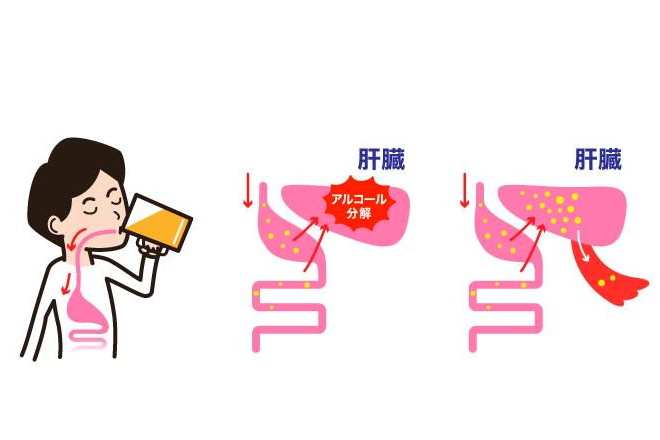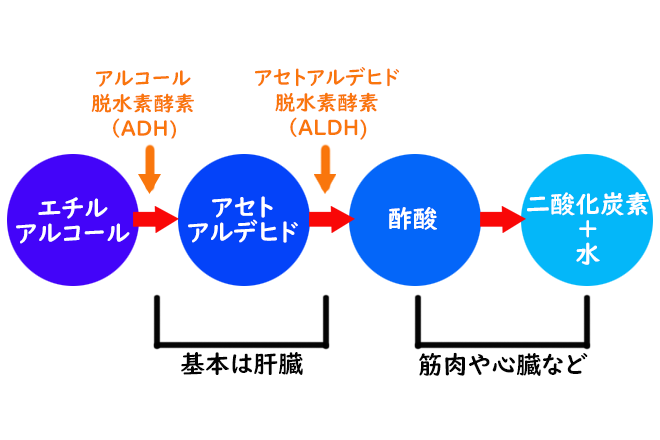2025.04.27
Decomposition of Alcohol and Acetaldehyde
The term “alcohol” commonly refers to beverages containing ethyl alcohol (ethanol), chemically represented as C2H5OH.
Ethyl alcohol is primarily metabolized in the liver, producing acetaldehyde (CH3CHO) as an intermediate.
Acetaldehyde is an essential industrial substance used as a raw material for acetic acid production and as a solvent for paints. However, elevated acetaldehyde levels in the body can cause hangovers, impair liver function, and induce inflammation due to its toxicity.
Initially, ethanol ingested into the body is converted into toxic acetaldehyde in the liver, which is then further metabolized into harmless acetic acid (acetate, CH3COOH). Subsequently, acetic acid is transported via the bloodstream, eventually being broken down into carbon dioxide and water.
This section explains the process by which ethanol enters the body, becomes acetaldehyde, and is eventually metabolized.
When alcoholic beverages are consumed, approximately 20% of the ethanol is absorbed in the stomach, and 80% in the small intestine. The absorbed ethanol rapidly enters the bloodstream within approximately 30 minutes to 2 hours, initially remaining as ethanol during this stage.

Next, ethanol circulating in the bloodstream passes through the liver.
Inside the liver, ethanol is oxidized into acetaldehyde by an enzyme called “alcohol dehydrogenase (ADH)”. This step is referred to as primary metabolism.
Alcohol dehydrogenase (ADH), also known as alcohol dehydrogenase enzyme, is found predominantly in the liver, though small amounts also exist in the stomach, intestines, kidneys, retina, and brain. However, the majority of acetaldehyde is produced in the liver.
Following primary metabolism, secondary metabolism occurs.
This phase converts the toxic acetaldehyde into harmless “acetic acid,” facilitated by an enzyme called “acetaldehyde dehydrogenase (ALDH)”.
Acetaldehyde dehydrogenase (ALDH) has two main types: ALDH1 (type 1) and ALDH2 (type 2). ALDH2 primarily catalyzes acetaldehyde’s oxidation into acetic acid, though ALDH1 also contributes to this process.
Individuals sensitive to alcohol typically have reduced ALDH2 activity. This genetic variation is especially prevalent among Japanese populations, explaining their general susceptibility to alcohol intolerance.

After acetaldehyde in the liver is converted into harmless acetic acid, it becomes acetyl-CoA and enters the “TCA cycle” (also known as the citric acid cycle or Krebs cycle). Here, it’s transformed into energy, carbon dioxide, and water, eventually excreted as urine.
Further details on the TCA cycle will be discussed in a future explanation. Alcohol and acetaldehyde metabolism, in essence, involve ethanol converting into toxic acetaldehyde, then harmless acetic acid, and ultimately into carbon dioxide and water.
If this metabolic process is impaired, acetaldehyde remains in the body, causing intoxication or lingering into the following day, resulting in a hangover.
The metabolism of alcohol primarily occurs within mitochondria in the liver cells. For mitochondria to efficiently metabolize alcohol, an adequate supply of oxygen, glucose, and energy derived from these substrates is essential.
2/2